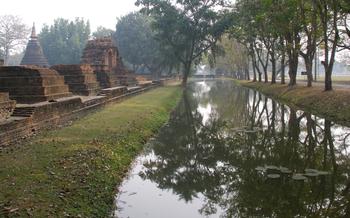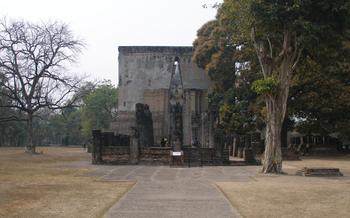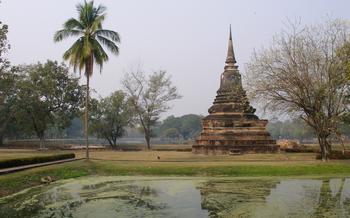
Chedi Ban Hua Laem Pagoda
- Religious and Spiritual Importance
- Location and Accessibility
- Dress Code and Etiquette
- Exploring the Pagoda Grounds
- Witnessing the Sunrise or Sunset
- Meditation and Spiritual Retreats
- Local Festivals and Events
- Surrounding Attractions:
- Shopping and Souvenirs
- Accommodation Options
- Language and Communication
- Safety and Security
Religious and Spiritual Importance
The Chedi Ban Hua Laem Pagoda holds profound religious and spiritual significance for the people of Ranong. It enshrines the relics of the Lord Buddha, which are believed to possess immense spiritual power and blessings. Devotees from far and wide come to the pagoda to pay homage, offer prayers, and seek guidance. For many, the pagoda serves as a place of solace and tranquility, where they can connect with their faith and find inner peace.
The pagoda's design and architecture are deeply rooted in Buddhist principles and beliefs. Its towering chedi, or stupa, symbolizes the Buddha's path to enlightenment and liberation from worldly desires. The intricate carvings and murals adorning the pagoda depict scenes from the Buddha's life and teachings, serving as visual reminders of his compassion and wisdom.
The pagoda is also a center for meditation and spiritual practice. Monks and laypeople alike come to the pagoda to engage in meditation sessions, seeking to calm their minds, cultivate mindfulness, and deepen their connection with the Dharma. The peaceful and serene atmosphere of the pagoda provides an ideal setting for introspection and spiritual growth.
Location and Accessibility
The Chedi Ban Hua Laem Pagoda stands tall in the Ban Hua Laem sub-district, situated approximately 20 kilometers northeast of Ranong city center. Its exact address is 233 Moo 4, Tambon Bang Rin, Amphoe Mueang Ranong. To reach the pagoda from the city, travelers can opt for various transportation options. Public buses and songthaews, the local shared taxis, offer convenient and affordable rides from the city center to the pagoda. Alternatively, renting a motorbike or car provides the flexibility to explore the surrounding areas at your own pace.
The pagoda is strategically located in close proximity to several major tourist attractions. The Ranong Hot Springs, renowned for their therapeutic properties, are just a short drive away. The picturesque Ko Phayam, a tranquil island known for its pristine beaches and laid-back atmosphere, is easily accessible by boat from Ranong town. Additionally, the Khao Ngao Wildlife Sanctuary, a haven for wildlife enthusiasts, is within reach for those seeking an encounter with Thailand's diverse flora and fauna.
Ample parking space is available for visitors to the Chedi Ban Hua Laem Pagoda. A dedicated parking area is situated adjacent to the temple grounds, providing convenience and security for travelers arriving by car or motorbike.
Dress Code and Etiquette
When visiting the Chedi Ban Hua Laem Pagoda, it is essential to dress respectfully and adhere to the temple's dress code. Modest clothing that covers your shoulders and knees is recommended. Avoid wearing shorts, tank tops, or revealing outfits.
Inside the temple grounds, maintain a respectful demeanor. Remove your shoes before entering the main prayer hall and keep your voice low. Walk calmly and avoid running or making unnecessary noise. When passing in front of the Buddha statue or monks, bow slightly as a sign of respect.
Remember that the pagoda is a sacred place for Buddhists. Be mindful of your actions and speech, and refrain from any behavior that may be considered disrespectful or offensive. Ask permission before taking photographs of people or religious objects, and always be respectful of the privacy of others.
Exploring the Pagoda Grounds
The Chedi Ban Hua Laem Pagoda showcases an array of captivating features that invite visitors to embark on a journey of exploration and discovery. The main highlight is the towering chedi, which stands tall as a symbol of devotion and faith. Its intricate design and exquisite ornamentation reflect the skill and artistry of ancient craftsmen. Visitors can circumambulate the chedi, paying their respects and soaking in the serene atmosphere.
Strolling along the well-laid paths and trails that encircle the pagoda offers a chance to admire the surrounding gardens, sculptures, and other attractions. Vividly colored flowers bloom in profusion, creating a vibrant tapestry that contrasts beautifully with the white chedi. Intricate sculptures depict scenes from Buddhist mythology and folklore, adding a touch of cultural and historical significance. Visitors can pause at gazebos and benches to rest and contemplate the tranquil surroundings.
Photography enthusiasts will find ample opportunities to capture stunning images of the pagoda and its environs. The best angles reveal the chedi's majestic grandeur against the backdrop of the azure sky or the golden hues of sunrise and sunset. With a keen eye and a steady hand, visitors can create picturesque memories of their visit to this sacred site.
Witnessing the Sunrise or Sunset
The Chedi Ban Hua Laem Pagoda offers a breathtaking spectacle for those who seek tranquility and beauty in nature. As the sun rises from the horizon, it casts a warm, golden glow upon the pagoda, creating a mesmerizing sight. The surrounding landscape is bathed in soft hues of pink, orange, and purple, creating a magical ambiance. Similarly, during sunset, the sky transforms into a canvas of vibrant colors, painting the pagoda in breathtaking hues as the sun descends below the horizon.
To capture the best views, position yourself at the elevated viewing platform near the pagoda. This vantage point provides a panoramic vista of the surrounding area, allowing you to witness the celestial display in its full glory. If you prefer a more secluded experience, explore the walking paths that lead to lesser-known viewpoints. These hidden spots offer a serene and intimate setting to soak in the beauty of the sunrise or sunset without the crowds.
Remember to arrive early to secure a good spot and avoid the rush. As the pagoda gains popularity, it's best to plan your visit accordingly. Bring a camera to capture the stunning vistas, and don't forget to embrace the tranquility of the moment. Let the serenity of the surroundings wash over you as you witness nature's masterpiece unfold before your eyes.
Meditation and Spiritual Retreats
The Chedi Ban Hua Laem Pagoda offers a serene and tranquil environment, making it an ideal destination for meditation and spiritual retreats. Visitors can find solace and inner peace amidst the beautiful surroundings and the calming atmosphere of the pagoda. Organized retreats or workshops are occasionally held, providing participants with guidance and instruction on meditation techniques, mindfulness practices, and Buddhist teachings. These retreats offer a unique opportunity to delve deeper into one's spiritual journey, promoting inner peace and tranquility. Local monks or teachers are also available to provide guidance and support to those seeking spiritual enlightenment.
Local Festivals and Events
The Chedi Ban Hua Laem Pagoda is not just a place of religious significance but also a hub for vibrant local festivals and events throughout the year. One of the most notable celebrations is the annual Ranong Boat Procession Festival, coinciding with the Buddhist Lent in October. This spectacular event showcases a colorful procession of decorated boats parading along the Ranong River, accompanied by lively music, dance performances, and fireworks. Visitors can witness this vibrant spectacle from the pagoda grounds, enjoying a unique blend of religious devotion and cultural festivities.
Another significant event is the Loy Krathong Festival in November, when locals gather at the pagoda to release beautifully crafted krathongs, or lotus-shaped floats, into the river. These krathongs carry offerings to the water spirits and symbolize letting go of past grievances and sins. During this time, the pagoda's surroundings are adorned with intricate lanterns and lights, creating a magical and enchanting atmosphere.
Surrounding Attractions:
The Chedi Ban Hua Laem Pagoda is just one of the many captivating attractions in the Ranong province. To fully immerse yourself in the region's charm, consider combining your visit to the pagoda with explorations of other nearby gems.
Within a short distance, you can find pristine beaches, mysterious caves, and awe-inspiring natural wonders. Laem Son Beach, with its crystal-clear waters and soft white sand, is a popular spot for swimming, sunbathing, and enjoying water sports. For a more adventurous experience, explore the Tham Phraya Nakhon Cave, home to a hidden lagoon and adorned with impressive stalactites and stalagmites.
To experience the unspoiled beauty of Ranong's nature, venture to Khao Ngao Wildlife Sanctuary, which boasts lush forests, cascading waterfalls, and diverse wildlife. Birdwatchers can delight in spotting exotic species, while nature enthusiasts can embark on hiking trails and discover hidden gems off the beaten path.
By creating a comprehensive itinerary that includes both the Chedi Ban Hua Laem Pagoda and these surrounding attractions, you'll gain a deeper appreciation for Ranong's rich cultural and natural heritage. Don't miss the opportunity to explore beyond the pagoda and uncover the hidden treasures that await.
Shopping and Souvenirs
The Chedi Ban Hua Laem Pagoda is surrounded by a vibrant market where artisans display their handcrafted souvenirs and local delicacies. Visitors can find unique items such as intricate wood carvings, colorful woven textiles, and handmade jewelry made from natural materials. Supporting these local businesses not only helps the community but also ensures that traditional skills and crafts are preserved.
Bargaining is a common practice in Thai markets, and visitors can often negotiate prices with the friendly vendors. It's worth noting that while haggling is acceptable, it should be done respectfully and without causing offense. The market also offers a variety of Thai snacks and treats, including fresh fruits, sweet desserts, and spicy street food. Visitors can indulge in local flavors while browsing the stalls, creating a truly immersive and authentic experience.
Accommodation Options
When planning your visit to the Chedi Ban Hua Laem Pagoda, a variety of accommodation options are available to suit different budgets and preferences. For those seeking a comfortable stay, numerous hotels, guesthouses, and resorts are situated within proximity to the pagoda. Budget-conscious travelers can find affordable guesthouses and hostels offering basic amenities.
For those seeking a more luxurious experience, several upscale resorts provide stunning views of the pagoda and the surrounding landscape. It is advisable to book accommodation in advance, particularly during peak tourist seasons, to avoid any inconveniences. Consider factors such as proximity to the pagoda, amenities, and budget when selecting your accommodation.
Language and Communication
Navigating language barriers in Thailand can be a unique adventure. While English is understood in major tourist areas, Ranong may present some challenges. However, embracing this aspect can lead to enriching experiences. Learning a few basic Thai phrases, such as "hello" (sawasdee) and "thank you" (kop khun), can go a long way in showing respect and bridging the gap. Translation apps can be handy, but nothing beats interacting with locals and practicing your language skills. Don't be afraid to smile and use gestures; sometimes, communication transcends words. Remember, embracing the language and cultural nuances is part of the adventure, and locals will appreciate your effort to connect with them.
Safety and Security
Ranong is generally a safe destination, and the Chedi Ban Hua Laem Pagoda is no exception. However, as with any travel destination, it's essential to exercise caution and take necessary precautions. Here are some safety tips to keep in mind:
- Be aware of your surroundings and belongings, especially in crowded areas.
- Avoid carrying large amounts of cash or valuables.
- Dress respectfully and modestly, covering your shoulders and knees when visiting the pagoda.
- Respect local customs and traditions, such as removing your shoes before entering the temple grounds.
- Be cautious of scams and unwanted solicitations, particularly from tuk-tuk drivers or street vendors.
- Always negotiate prices for goods and services before making a purchase.
- Avoid drinking tap water and opt for bottled water instead.
- Learn basic Thai phrases, such as "hello," "thank you," and "goodbye," to communicate with locals.
- In case of an emergency, dial 191 for police assistance or 199 for medical assistance.
- Respect local laws and regulations, including those related to drug use, gambling, and alcohol consumption.




